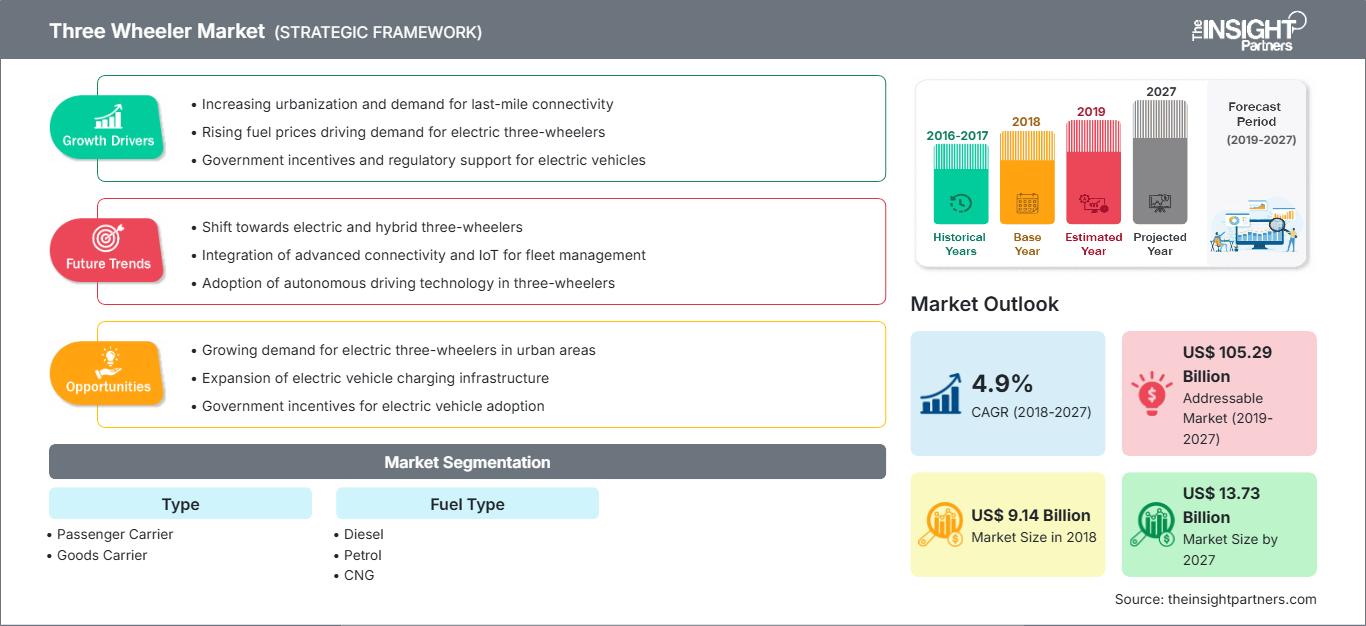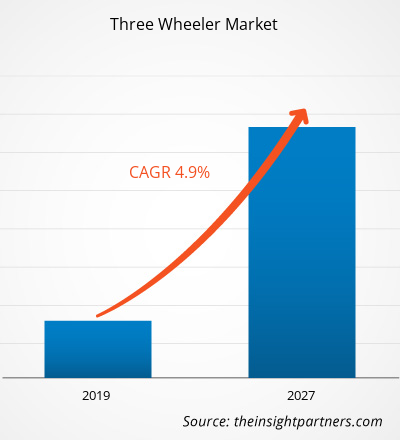Il mercato dei veicoli a tre ruote è stato valutato a 9,14 miliardi di dollari nel 2018 e si prevede che crescerà a un CAGR del 4,9% dal 2019 al 2027, raggiungendo i 13,73 miliardi di dollari entro il 2027.
I veicoli a tre ruote sono veicoli a tre ruote utilizzati per il trasporto di passeggeri. I veicoli a tre ruote possono trasportare un minimo di tre e un massimo di cinque-sei passeggeri. Nelle aree rurali, i veicoli a tre ruote possono trasportare più di sei passeggeri, a seconda delle esigenze. Il risciò elettrico è uno dei principali tipi di veicoli a tre ruote. I risciò elettrici funzionano a batteria e sono veicoli ecologici, con emissioni ridotte e minore rumore rispetto ai veicoli a tre ruote convenzionali. I risciò elettrici possono trasportare cinque-sei passeggeri. La crescente domanda di veicoli elettrici a tre ruote, l'aumento demografico e la crescente necessità di un veicolo che aiuti a ridurre la congestione del traffico nella regione hanno sostenuto la crescita del mercato globale dei veicoli a tre ruote. Nel 2018, la regione APAC detiene una posizione di rilievo nel mercato dei veicoli a tre ruote durante il periodo di previsione. Si prevede che paesi come l'India domineranno il segmento del mercato interno ed estero durante il periodo di previsione. Inoltre, molti operatori affermati in India si stanno concentrando sulla produzione di veicoli a tre ruote conformi alle norme BS (Bharat Stage) VI, che saranno implementate entro il 2020 per tenere sotto controllo le emissioni di particolato, ossidi di azoto e zolfo. Si osserva una crescita significativa in Cina, seguita da altri paesi asiatici come Thailandia e Malesia, a causa della crescente necessità di mezzi di trasporto per le aree rurali e semiurbane del paese e della crescita demografica.
Personalizza questo rapporto in base alle tue esigenze
Potrai personalizzare gratuitamente qualsiasi rapporto, comprese parti di questo rapporto, o analisi a livello di paese, pacchetto dati Excel, oltre a usufruire di grandi offerte e sconti per start-up e università
Mercato delle tre ruote: Approfondimenti strategici

-
Ottieni le principali tendenze chiave del mercato di questo rapporto.Questo campione GRATUITO includerà l'analisi dei dati, che vanno dalle tendenze di mercato alle stime e alle previsioni.
L'industria automobilistica in tutto il mondo sta assistendo a un costante aumento del numero di nuovi produttori di veicoli a tre ruote. I produttori di veicoli a tre ruote osservano costantemente lo sviluppo del segmento dei veicoli a tre ruote elettrici, poiché questo segmento sta attirando l'interesse dei clienti a livello globale. L'industria automobilistica globale sta vivendo un passaggio significativo dai veicoli a tre ruote tradizionali a quelli elettrici.
I governi di diversi paesi stanno prendendo iniziative per l'adozione di veicoli a tre ruote elettrici. Ad esempio, nel marzo 2018, il Ministero dell'Industria Pesante e delle Imprese Pubbliche dell'India ha lanciato la Fase II del programma FAME India, che è stato avviato il 1° aprile 2019 per i prossimi tre anni, con un sostegno di bilancio totale di 1,39 miliardi di dollari. Questa fase è stata avviata principalmente per supportare l'elettrificazione dei veicoli pubblici e Il trasporto condiviso mira a supportare, attraverso sussidi, 7.000 autobus elettrici, 500.000 veicoli elettrici a 3 ruote, 55.000 autovetture elettriche a 4 ruote e 100.000 veicoli elettrici a 2 ruote. Questa fase del programma FAME mira a creare un'adeguata infrastruttura di ricarica pubblica per sviluppare la fiducia tra gli utenti di veicoli elettrici. A tal fine, il Ministero dell'Industria Pesante e delle Imprese Pubbliche auspica il coinvolgimento e la partecipazione attiva di vari stakeholder, tra cui industrie, imprese del settore pubblico (PSE) ed enti governativi. I principali attori del mercato puntano allo sviluppo di veicoli elettrici. Ad esempio, Piaggio & C. SpA, produttore italiano di veicoli a motore, ha lanciato Piaggio Ape E-City nell'ambito della sua gamma di veicoli elettrici a 3 ruote Piaggio Ape Electrik. L'auto elettrica è dotata di una batteria agli ioni di litio intercambiabile e può coprire un'autonomia di circa 70-80 km con una sola ricarica. Inoltre, nell'agosto 2019, Euler Motors ha annunciato il lancio di veicoli commerciali leggeri elettrici a tre ruote in India all'inizio del 2020.
Geograficamente, India e Cina ospitano numerosi produttori di veicoli a tre ruote, e l'accettazione dei veicoli elettrici a tre ruote sta aumentando rapidamente di anno in anno. Oltre a India e Cina, anche paesi del Sud America, come Brasile e Argentina, e paesi del Medio Oriente e dell'Africa come Sudafrica, Nigeria ed Egitto, stanno sviluppando rapidamente l'adozione di veicoli elettrici a tre ruote nel settore automobilistico. La regione Asia-Pacifico ha dominato e sta assistendo a un'enorme crescita del settore automobilistico. Tuttavia, gli operatori del settore automobilistico che operano nella regione necessitano di un numero maggiore di partnership con i fornitori di componenti, per aumentare esponenzialmente in termini di implementazione di veicoli elettrici a tre ruote. Le partnership strategiche, la collaborazione, i contratti e le acquisizioni con altri operatori del mercato sono i fattori principali che consentono agli operatori del settore di guidare i propri mercati, che si stima guideranno il mercato dei veicoli a tre ruote in tutto il mondo nei prossimi anni.
Approfondimenti sulla tipologia
Nel segmento della tipologia, il trasporto passeggeri ha conquistato la quota maggiore del mercato globale dei veicoli a tre ruote. Il trasporto passeggeri è il mezzo di trasporto più economico che può essere offerto da vari operatori di trasporto privati e da privati che guadagnano con il trasporto. La crescita del segmento è trainata dalla crescente domanda di veicoli a tre ruote a basso costo, come la mancanza di strade adeguate; i veicoli a tre ruote sono principalmente dovuti a infrastrutture di trasporto inadeguate e alle aree urbane con traffico intenso.
Approfondimenti sulla tipologia di carburante
Il mercato dei veicoli a tre ruote, in base alla tipologia di carburante, è segmentato in diesel, benzina, metano, GPL ed elettrico. Il segmento benzina ha conquistato una quota dominante nel mercato globale dei veicoli a tre ruote.
L'iniziativa di mercato è una strategia adottata dalle aziende per espandere la propria presenza in tutto il mondo e soddisfare la crescente domanda dei clienti. Gli operatori del mercato presenti nel mercato dei veicoli a tre ruote si concentrano principalmente sul miglioramento di prodotti e servizi integrando funzionalità e tecnologie avanzate. Firmando partnership, contratti, joint venture e inaugurando nuove sedi in tutto il mondo, le aziende stanno cercando di aumentare la propria quota di mercato e la presenza del marchio. La maggior parte delle iniziative di mercato è stata osservata nella regione Asia-Pacifico, che presenta un elevato potenziale di crescita futura. Alcune di esse sono elencate di seguito;
2019: A dicembre 2019, Greaves Cotton ha annunciato una partnership con TVS Motor Company. In base a questa partnership, Greaves Cotton avrebbe agito come centro di assistenza autorizzato per i veicoli a tre ruote di TVS Motor in India. 2018: ATUL Auto Limited ha stretto una partnership con JBM Industries, un'azienda di ricambi auto con sede in India. L'azienda ha stretto una partnership per espandere la propria attività nel settore dei veicoli elettrici a tre ruote.
Mercato dei veicoli a tre ruote
Le tendenze regionali e i fattori che influenzano il mercato dei veicoli a tre ruote durante il periodo di previsione sono stati ampiamente spiegati dagli analisti di The Insight Partners. Questa sezione analizza anche i segmenti e la geografia del mercato dei veicoli a tre ruote in Nord America, Europa, Asia-Pacifico, Medio Oriente e Africa, America meridionale e centrale.
Ambito del rapporto sul mercato dei veicoli a tre ruote
| Attributo del rapporto | Dettagli |
|---|---|
| Dimensioni del mercato in 2018 | US$ 9.14 Billion |
| Dimensioni del mercato per 2027 | US$ 13.73 Billion |
| CAGR globale (2018 - 2027) | 4.9% |
| Dati storici | 2016-2017 |
| Periodo di previsione | 2019-2027 |
| Segmenti coperti |
By Tipo
|
| Regioni e paesi coperti |
Nord America
|
| Leader di mercato e profili aziendali chiave |
|
Densità degli operatori del mercato dei veicoli a tre ruote: comprendere il suo impatto sulle dinamiche aziendali
Il mercato dei veicoli a tre ruote è in rapida crescita, trainato dalla crescente domanda degli utenti finali, dovuta a fattori quali l'evoluzione delle preferenze dei consumatori, i progressi tecnologici e una maggiore consapevolezza dei vantaggi del prodotto. Con l'aumento della domanda, le aziende stanno ampliando la propria offerta, innovando per soddisfare le esigenze dei consumatori e sfruttando le tendenze emergenti, alimentando ulteriormente la crescita del mercato.

- Ottieni il Mercato delle tre ruote Panoramica dei principali attori chiave
- Trasportatore passeggeri
- Trasportatore merci
Mercato dei veicoli a tre ruote - Per tipo Per tipo di carburante
- Diesel
- Benzina
- CNG
- GPL
- Elettrico
Mercato globale dei veicoli a tre ruote per regione
-
Nord America
- Stati Uniti
- Canada
- Messico
-
Europa
- Francia
- Germania
- Italia
- Regno Unito
- Russia
- Resto d'Europa
-
Asia Pacifico
- Cina
- India
- Corea del Sud
- Giappone
- Australia
- Resto dell'Asia Pacifico
-
Resto del Mondo
- Africa
- America Latina
Profili aziendali
- ATUL Auto Limited
- Bajaj Auto Ltd.
- JS AUTO (P) LTD.
- Mahindra & Mahindra Ltd.
- Piaggio & C. SpA
- Scooters India Limited
- Speego Vehicles Co Pvt Limited
- Terra Motors Corporation
- TVS Motor Company
- Xianghe Qiangsheng Electric Tricycle Factory
- Analisi storica (2 anni), anno base, previsione (7 anni) con CAGR
- Analisi PEST e SWOT
- Valore/volume delle dimensioni del mercato - Globale, Regionale, Nazionale
- Industria e panorama competitivo
- Set di dati Excel
Report recenti
Rapporti correlati
Testimonianze
Motivo dell'acquisto
- Processo decisionale informato
- Comprensione delle dinamiche di mercato
- Analisi competitiva
- Analisi dei clienti
- Previsioni di mercato
- Mitigazione del rischio
- Pianificazione strategica
- Giustificazione degli investimenti
- Identificazione dei mercati emergenti
- Miglioramento delle strategie di marketing
- Aumento dell'efficienza operativa
- Allineamento alle tendenze normative






















 Ottieni un campione gratuito per - Mercato delle tre ruote
Ottieni un campione gratuito per - Mercato delle tre ruote